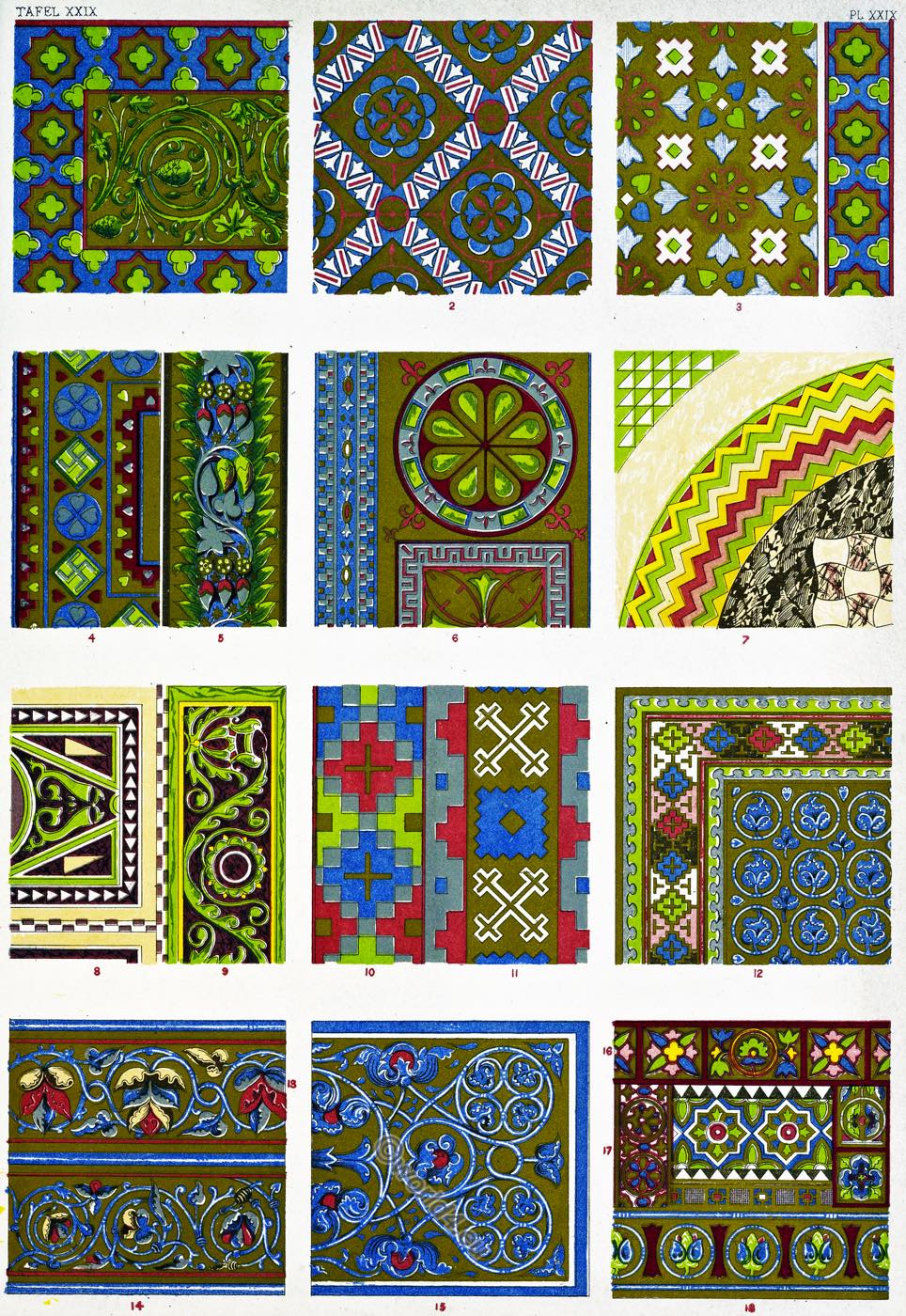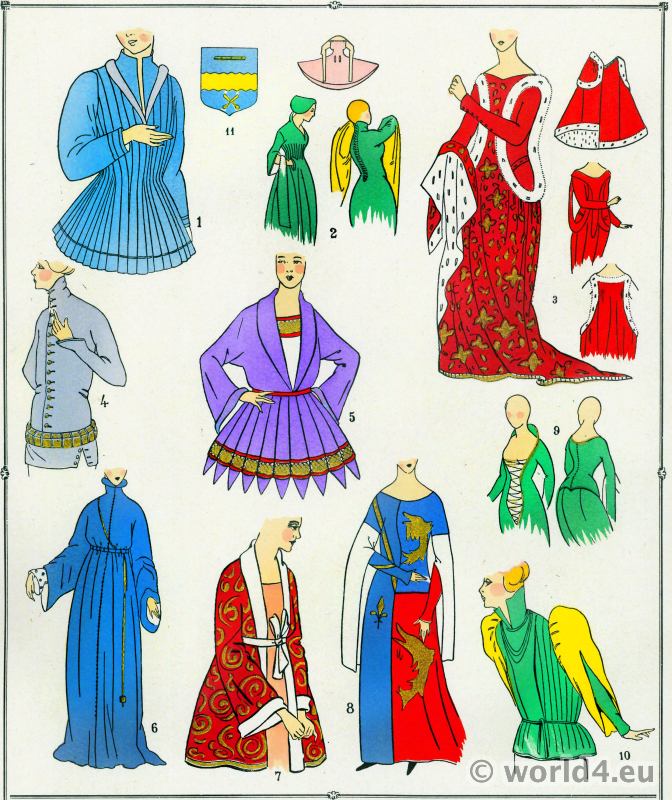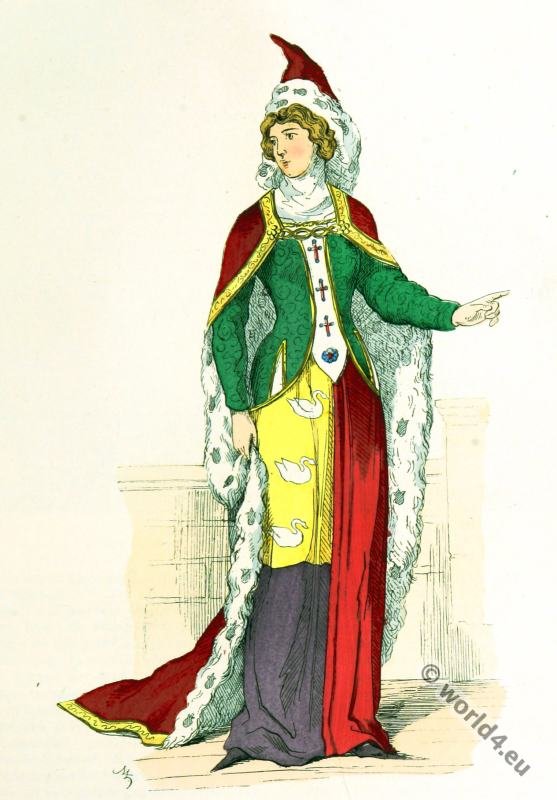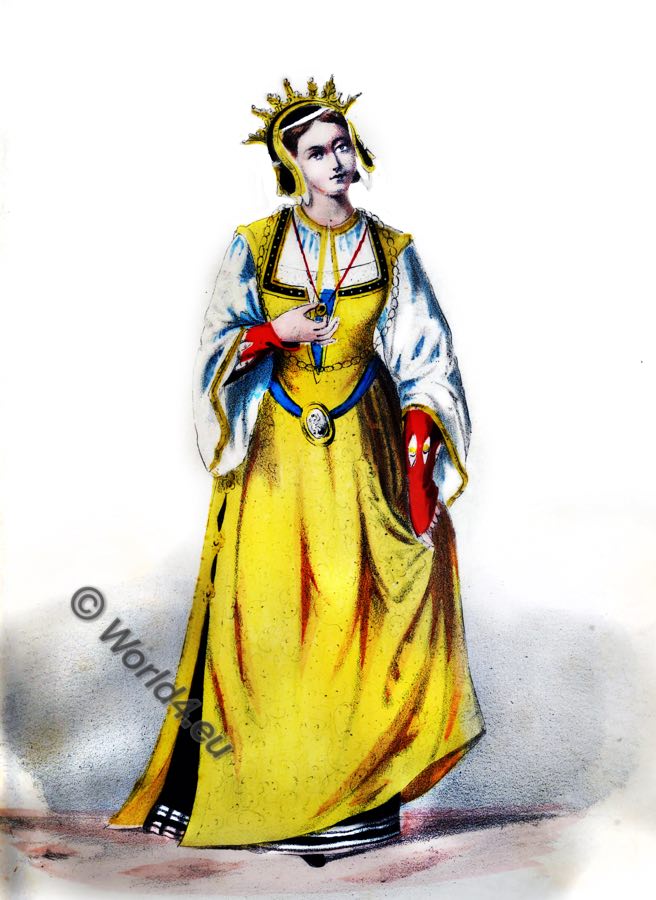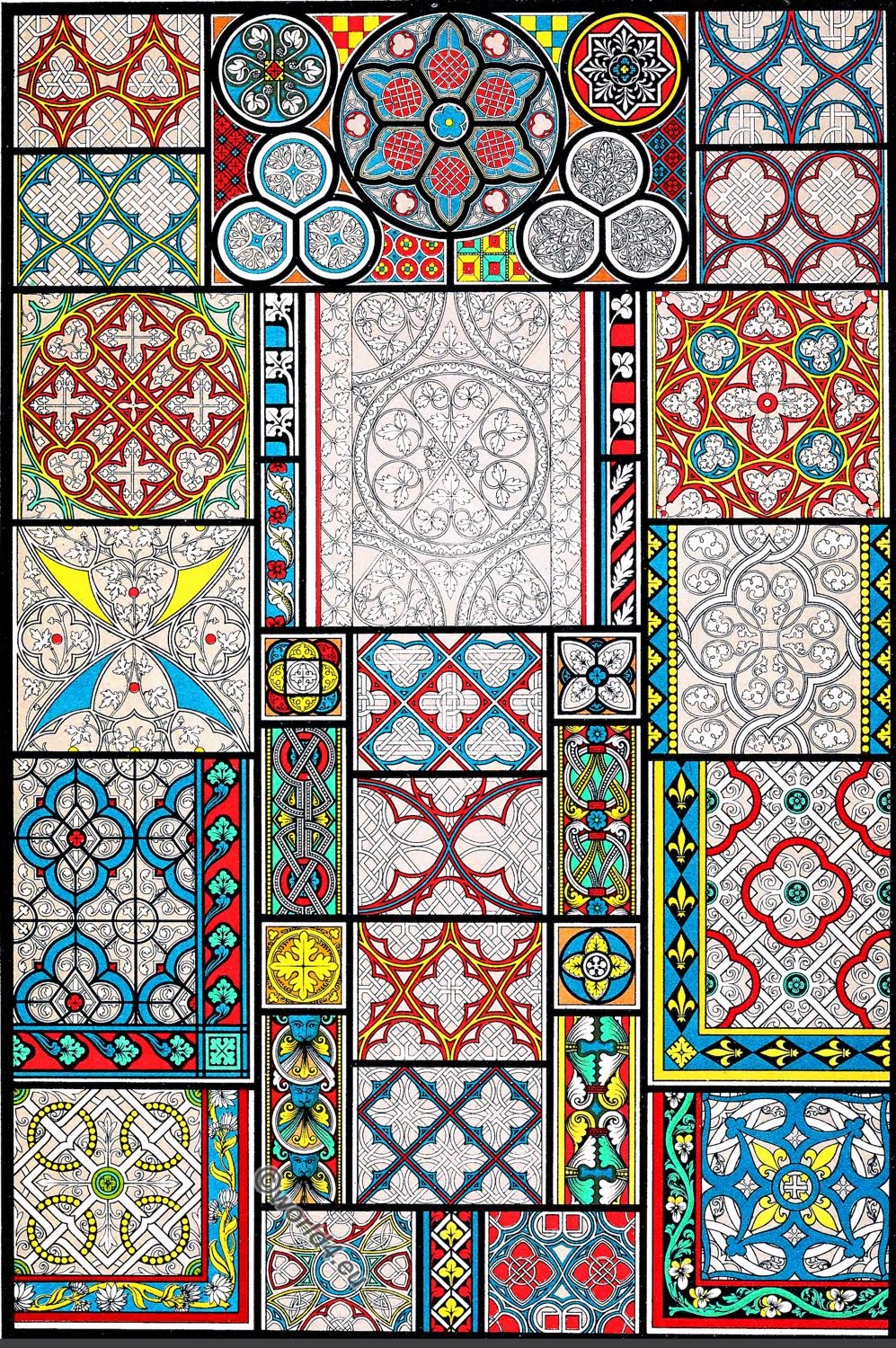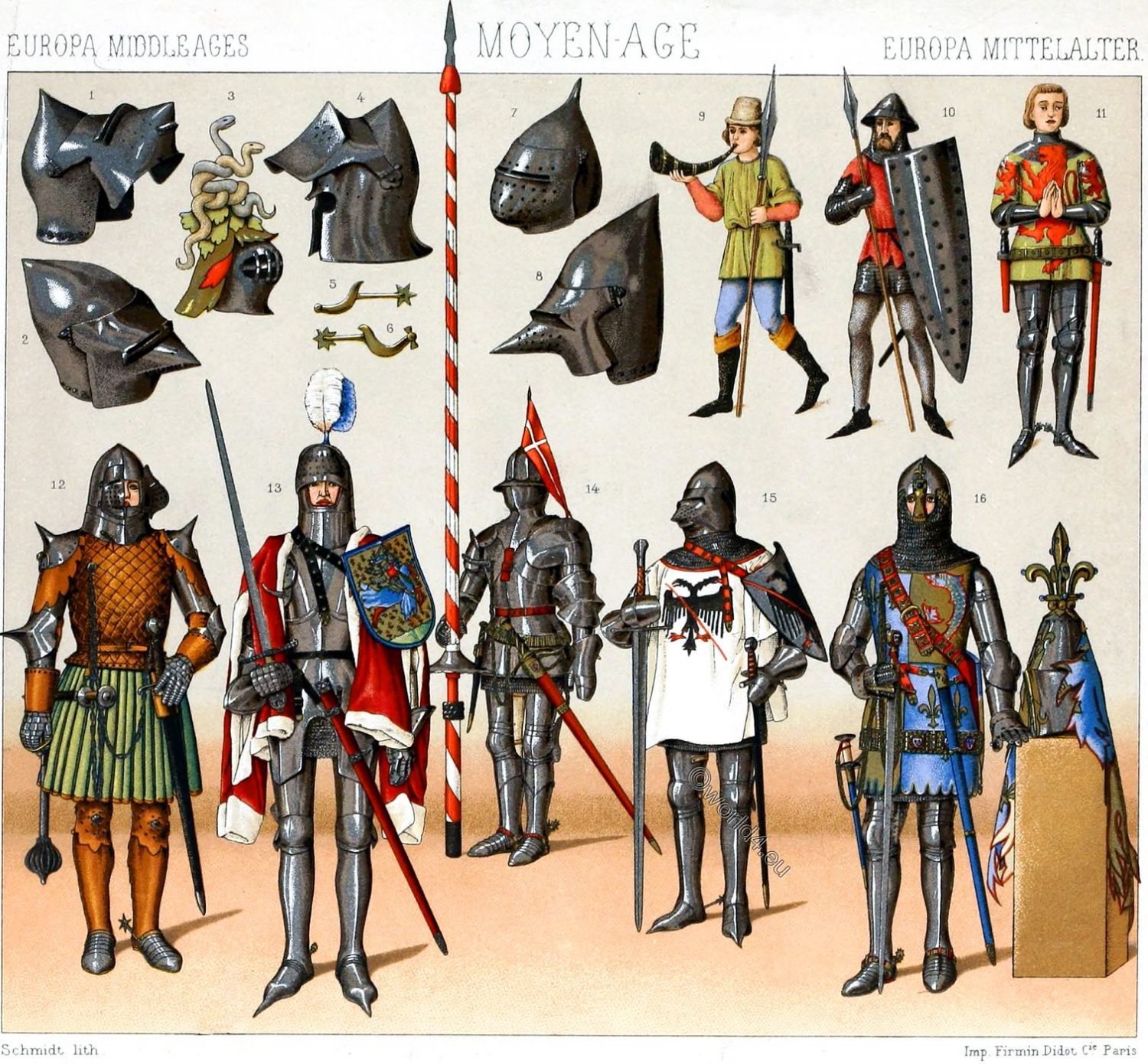
EUROPE. MIDDLE AGES. FRANCE. WAR ARMAMENTS FROM 1350 TO ABOUT 1460. LEATHER ARMOUR. – BUCKET HELMETS. – IRON HATS etc.
No. 12 – Knight from the last half of the 14th century (time of King John).
The widespread use of leather in combination with iron belongs to a transitional period which follows the use of the chain mail or broigne and precedes the complete plate armour. In order to reduce the shock or impact, the chain mail or broigne was first fitted with a breastplate, then the same system was applied to the arm and leg protection. This gradual transformation of the armour continued throughout the 14th century, and it was not until around 1400 that the breastplate, composed of a breastplate and backplate, was finally adopted.
The armour depicted here is that of a rider who is also equipped for combat on foot. It is symmetrical, and not, as since the organisation of the compagnie d’ordonnance by Charles VII around 1445, designed for the use of the lance. The Ordinance Companies created by King Charles VII and the French Estates General (French: états généraux), are considered the beginning of the first standing army in Europe.
The helmet shows the transition from pot helmet (great helm or heaume) to the Bascinet. Its visor consists of two parts opening sideways in hinges; it has an extension consisting of two rails that serve as neck protection. The quilted leather armour covers a breastplate and resembles the brigandine used by foot soldiers in the 14th and 15th centuries. An apron made of leather covered with fabric falls down from the belt. Leather shoulder pieces cut out in the shape of a tongue, pointed armpits and elbows, steel arm and leg splints, as well as the knees covered with boiled leather. Iron glove with split fingers and footwear composed of splints.
Serve as offensive weapons: The mace with wooden handle and fist strap, the short sword in leather sheath and the dagger, the latter attached to the armour by long chains. Cf. Spores no. 5 which belongs to this armour.
No. 16 – Armour of the Dauphin, son of King John II of France, later Charles V (French: Charles V le Sage). Balaclava (Cervelière) with movable nose guard. The large helmet, which was worn over this iron cap, with lily-shaped helmet ornament and blue helmet cover stands next to it. Arm and leg splints. The blue surcoat is covered with heraldic drawings and is covered by the belt of knights decorated with enamels and stars. This belt has nothing to do with the baldric. The shield of particularly small dimensions hangs from a richly decorated bandelier. Sword and dagger are attached to the armour with chains.
No. 15 – Armament of war. Charles V era. The armour bears the coat of arms of du Guesclin (Bertrand du Guesclin 1320-1380). Full armouring made of iron plates with a skirt-like extension. Surcoat in the shape of a dalmatica. Bascinet bonnet with visor over a hood of ring mesh. Small shield made of silver-plated and painted wood. In addition to the sword, a large two-handed sword, for the battle on foot. Around 1300, the Bascinet first appeared, by adding a visor to the bare iron cap.
Around 1350, a bavière, a fixed neck guard on which the lowered visor rested, was added to the Bascinet helmet. Since 1380, the Bascinet helmet has been joined to a neck guard consisting of rails, which is part of the armour. Around 1435 it was replaced by the salade and the full-face helmet (armet).
No. 1, 2, 4, 7 and 8 – Bascinet helmets; No. 4 and 7 English; end of the 14th century. They show the different shapes of the visor, all of which are slanted or pointed in order to derive the force of a blow guided by the face.
No. 14 – Knight with the coat of arms of the Xaintrailles *). (Early 15th century, reign of Charles VI). Iron helmet with protruding, knocked down rim without eye holes, followed by a bavière strapped over the breastplate. A flag with a white cross on a red field serves as a crest decoration. The plate armour with strong shoulder and elbow tiles is placed over a chain mail. Sword and dagger attached to the knight’s belt, also attached to the armour by chains. The shoulder pieces are unequal for the purpose of inserting the long lance.
*) Jean Poton de Xaintrailles (probably 1390 or 1400 in Gascony – 7th October 1461 in Bordeaux) was a minor noble of Gascon origin and one of the chief lieutenants of Joan of Arc during the Hundred Years’ War. In 1424 Xaintrailles served the Duke of Burgundy Philip III as a mercenary and later entered the service of the French forces of King Charles VII. In 1454 he was appointed a Marshal of France.
No. 13 – Charles of Orleans. (15th century, government of Charles VII). The head protection is a Bascinet helmet with open visor, chin and neck protection. The armour is similar to the one shown under no. 14, only hip pockets have been added. The leg splints go up to above the heel, so that the spores have been directly riveted in. The tips of the pointed shoes have been designed so that they could be removed for foot-fighting. The belt carries the sheath of the sword. A tabard in the shape of a dalmatika, a coatine, a huque (hoike) with flying sleeves or the journade, a kind of open jacket without collar with slit, long hanging sleeves, was generally used as a surcoat. At that time the armour is still as simple as possible and shows only the traces of the hammer without chasing and inlays.
No. 10 – Foot soldier with the Pavois (time of Charles V). The Pavescheurs (militia), as Froissart calls them, served on foot or on horseback. Their favourite weapon was the javelin, Glaivelot. They wore an iron helmet as a headgear; their bodies were protected by a chain mail under a quilted doublet, jacque or jacquet. The pavois is the large long shield covering the whole body, which they placed in front of them or hung over their backs when storming fixed places.
No. 9 – Trumpeter, Busineor 14th and 15th century (The word comes from busine, or buisine, or busun, a Middle Ages military trumpet. This term in turn refers to the Latin buccina). The busine is made of wood, boiled leather or brass and has the simple shape of a horn curved upwards.
No. 11 – John, Lord of Florigny, 1415 (the time of Charles VI). The picture comes from the church of the abbey of Estrée. The shortness of the sword, dagger and surcoat is remarkable.
No. 3 – Italian helmet of the 15th century; a variation of the Armet.
The small potted helmet, Armet, corrupted from Heaumet, shows a lattice instead of the visor. The helmet decoration consists of intertwined snakes. The helmet cover is only partially depicted.
All illustrations after photographs except 9, 10 and 11 in the Gaignières Collection in the Print Room of the National Library in Paris, and No. 3 (in the Prefecture of Pistoja). Nos. 12, 13, 14, 15 and 16 from the war costumes in the Musée d’artillerie in Paris. Nos. 1, 2, 4, 7 and 8 form part of this collection.
Cf. Notice sur les Costumes de guerre du Musée d’artillerie (Paris 1876). – Catalogue of this collection by O. Pengtlilly L’Haridon.Viollet-le-Duc, Dictionnaire raisonné du mobilier francais: armes de guerre. – Quicherat, Histoire du costume en France.
Source: History of the costume in chronological development by Auguste Racinet. Edited by Adolf Rosenberg. Berlin 1888.
Related
Discover more from World4 Costume Culture History
Subscribe to get the latest posts sent to your email.

